It is always interesting to see the surprise of those who think the
countryside ends at a straight line drawn across the map from London to
Bristol, and who believe that anything north of that line consists of a
world of narrow streets, terraced houses, wall to wall factories and
industrial grime.
Our friends from Gosport visited a few weeks ago. They have been in
the navy all their lives and now they are retired, and live in a house
situated on an isthmus, a marina on one side and the main harbour on the
other. They can watch the daily ferries from their windows as well as
the private yachts and motor launches. To reach Portsmouth it is quicker
to take the ferry than to struggle through the continuous traffic. They
could not believe we had so much open space, green fields and trees and
that the air we breathed was fresher than the Gosport variety. They
waxed lyrical and endlessly on "How green everything was" and " We
didn't think it would be like this", and it made me view our environment
with new eyes. It really was green and fresh and clean and this thought
made me think of my childhood and where I grew up and played. As a
result I visited my childhood home and revisited the fields where I had
played. I walked along the old original footpaths which were short cuts
from one road to another. Amazingly, most were still there, they had not
been built upon, although, to some extent they were changed, but then
not everything can stand still, nor, I suppose, should it.
|
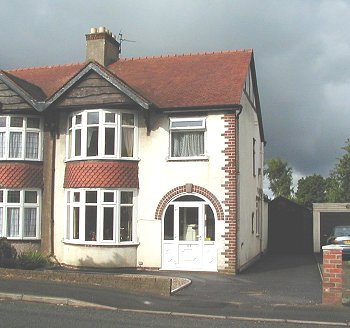
Number 117 Windsor Avenue. |
My first home was at 117 Windsor Avenue, Penn. A
road which starts from Coalway Road and climbs to Penn Road.
About half way, there is a slight downwards slope, before it
starts to climb again. At this point there is a concrete covered
culvert at right angles to the road which leads to adjacent
fields and the name of the road also changes to Pennhouse
Avenue, a mystery which I could never understand. We lived on
the right-hand side of the road in a typical semi-detached house
of the period, when strip development was common. We had a
lounge, dining room, kitchen with triplex oven and a scullery.
The last two were separated by a coalhouse. |
| An inside coalhouse; only a man could have come
up with that idea. It was a never ending source of coal dust and drove my mother to
distraction. Upstairs there were 3 bedrooms and a bathroom.
Outside a drive and a garage, built by my father, which is still
standing. The garden was long and narrow and went down to the
fields at the back. We spent all our free time playing there.
The fields were divided by hedges and grazed by cows which
belonged to the local farmer. |

Looking up towards Pennhouse Avenue. |
|
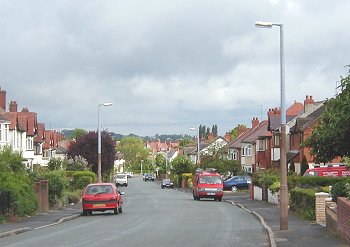
Looking down Windsor Avenue towards
Coalway Road. |
I realise now, having seen fields full of
Friesian and Jersey cows, that they were a hybrid bunch, brown,
white, black, with their horns still attached and I always gave
them a wide berth. The cows belonged to Mr. Read and Mr. Mansell
who lived just across the road. Mrs Mansell was the Read's
sister. One entered the farmyard by walking along what is now
the entrance to Kingswood Gardens. The cow sheds were on the
left and the farmhouses faced them across the farmyard, and
behind the houses were fields. |
| All gone now and replaced by modern houses. The
right of way through the farmyard is still there and it is still
possible to walk through Kingswood Gardens to the path at the
back, which runs from Coalway Road to Osborne Road. The path was
used as a short cut when going to school at Woodfield Avenue. I
walked along the footpath again, it seemed shorter and narrower
than I remembered, but still there and being used by children
and parents as a shortcut. |
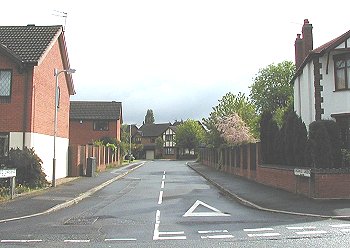
Kingswood Gardens where the farm once
stood. |
|
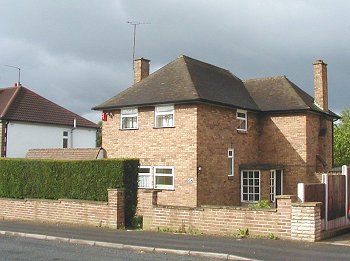
Number 107 Windsor Avenue. |
Each day Mr. Mansell would drive the cows from the
farm, into Windsor Avenue, along the road turning right, through
a wide entrance, now occupied by number 107, and into the fields
where they spent their day grazing. In the evenings he would
drive them back to the farm to be milked. The cows plodding
along at their own pace, taking their time, and pushing their
horns through the hedge in our front garden and munching at the
dandelions as they passed. Turning patiently into the farmyard,
each one went to its own stall to be milked by hand, patiently
waiting their turn. |
| Each day Mr. Mansell, his flat cap at a jaunty
angle, would deliver the milk. He rode on a horse and cart, a
type of open cart with milk churns at the back.
The horse needed
no instructions, he stopped and started at all the customer's
houses and Mr. Mansell dispensed the milk from the churns.
He
would dip in the measure and bring it out of the milk, frothy
and creamy, and pour it into the largest jug we had. Milk was
rationed, but he always filled our jug and milk was one thing we
were never without. |
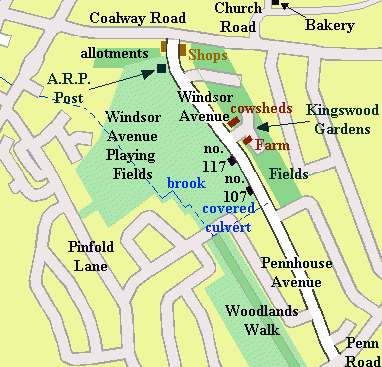
A map of Windsor Avenue and the
surrounding area. |
Deliveries were the norm. The baker, my mother called him fairy feet,
because he walked so quietly, came daily, his van was filled with a wide
choice of loaves. The fish man came once a week as did the man who
delivered stone bottles of lemonade and dandelion & burdock. The coalman
delivered using a horse and cart of course. The sweep came too, but on a
bicycle, taking the sack of soot away with him.
|
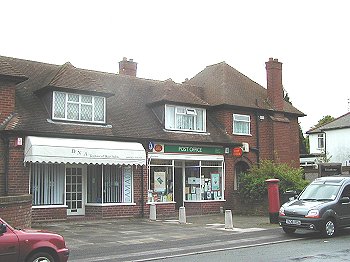
Windsor Avenue Post Office. |
At the bottom of the road there were a few shops,
a grocer, butcher, greengrocer and post office. The postmaster
was William Lawley, who became Mayor of Wolverhampton in the
late 1940's.
When the war started, my mother registered for our
rations with the local shops, and errand boys would deliver the
orders by bicycle. |
Adjacent to the greengrocer's there was an open piece of land which
leads straight into the fields at the back, it is now the main entrance
to Windsor Avenue playing fields. In the 1940's it was the site of an
A.R.P. post, demolished after the war. The allotments at the back of the
house in Windsor Avenue are now no longer there and have been replaced
by a copse of trees.
| Allotments are still there at the back of the
houses in Coalway Road. My father, like everyone else, had an
allotment and was urged "To dig for victory". One year he grew
too many parsnips and sold them to the local greengrocer, who
was delighted to get them. It is difficult to imagine in these
days of plenty, that in the 40's and 50's that there was no
choice, no endless varieties from which to choose. |
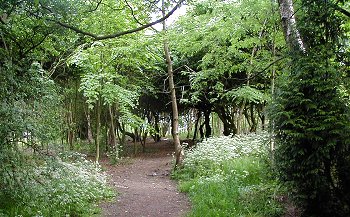
The site of the Windsor Avenue allotments. |
|

St. Philip's Church from the fields.
From an old postcard. |
The hens stopped laying in the winter and eggs had
to be laid down in isinglass. Peas and beans were not frozen but
had to be podded or sliced. The fruit was bottled or made into
jam, a special sugar allowance was given in the summer, and one
made one's own pickle, or went without. It seemed as if
everything was rationed, coal, clothes and even furniture. |
| Revisiting my old home, I found that the road had
not changed, it still rises towards Pennhouse Avenue, there is
still the slight decline and the road name changes halfway. The
fields at the back are still there as indeed is the brook in
which I used to paddle and where the cattle used to drink. The
hedges have gone and the fields are sports fields now. |

Coalway Road Playing Fields.
From an old postcard. |
|
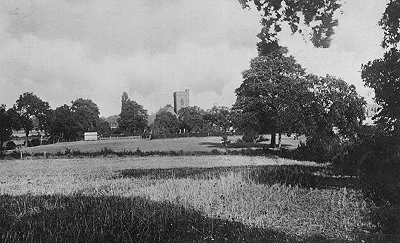
St. Philip's Church from the West.
From an old postcard. |
There are more trees but no hedges, they have all
been rooted out. The path from the fields up to the Penn Road is
still there, as is the concrete covered culvert.
However, I
could not find its entrance, not that I would have crawled up it
again, as I did as a child. It was a must for all children, we
crawled inside the culvert until we reached the entrance under
the road, Windsor Avenue, and out the other side into Osborne
Road. |
| I never ventured under the road, although others
did and lived to tell the tale. The concrete covered culvert is
now the only entrance to the fields at the far end of Windsor
Avenue. The entrance which Mr. Mansell used to drive his cows
into the fields is now occupied by number 107. During the war it
was occupied by a static water tank and the pig bins where
everyone put their waste food for the pigs. After the war the
tank was demolished and number 107 was built. |
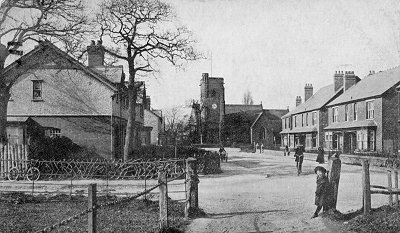
Church Road in about 1905.
From an old postcard. |
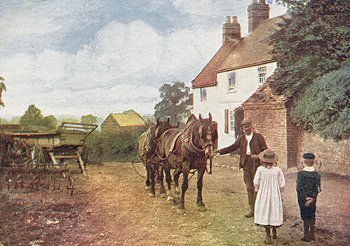
This picture from an old postcard is
actually a scene at Lower Penn, but it gives an idea of what it
was like in Windsor Avenue. |
The farm and cow sheds have gone, but
I can remember taking my dog's puppies there to have their tails
docked. Mr. Mansell was the chief surgeon.
Taking from his
waistcoat pocket an old pen knife, he sharpened it on the edge
of the wooden cow stall. Then laying each tail on the edge of
the stall he quickly sliced it off, returning each puppy,
tail-less, to their basket.
I watched with interest, I was only
7. I soon returned them to their mother who nearly wore out her
tongue licking the poor stumps better. |
So here is a mixture of reminiscences, some of which could never
happen today in our over protective society, but joy of joy, my fields
and brook and paths are still there. Even the pink campions are still
blooming. The hedgerows have gone and Mr. Mansell and his churns of milk
are only a memory. Never the less we are still green north of London. We
still have space and the trees still blossom and we have paths and open
spaces and babbling brooks to enjoy. Perhaps we should guard our secret
well or those who believe we are totally built-up may invade our open
spaces.
|

|
|
Return to the
previous page
|
|















